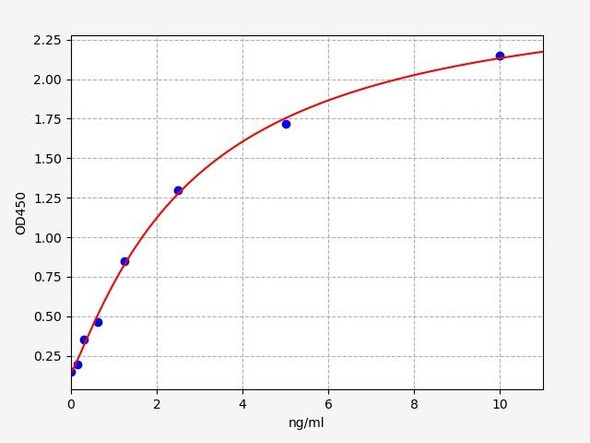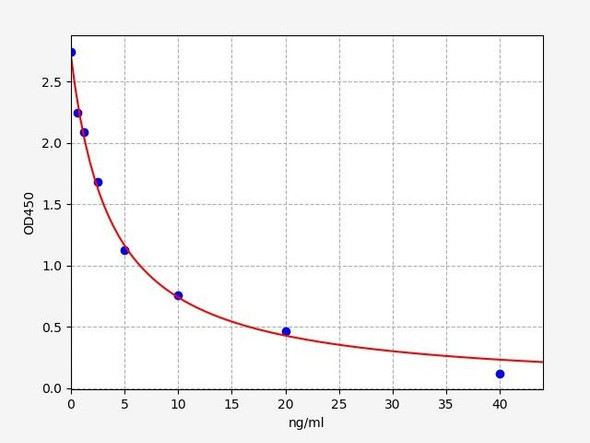Human E3 ubiquitin-protein ligase HACE1 (HACE1) ELISA Kit (HUEB2446)
- SKU:
- HUEB2446
- Product Type:
- ELISA Kit
- Size:
- 96 Assays
- Uniprot:
- Q8IYU2
- Range:
- 0.156-10 ng/mL
- ELISA Type:
- Sandwich
- Synonyms:
- HACE1, HECT domain and ankyrin repeat-containing E3 ubiquitin-protein ligase 1, HACE1, KIAA1320, 6.3.2.-
- Reactivity:
- Human
Description
Human E3 ubiquitin-protein ligase HACE1 (HACE1) ELISA Kit
The Human E3 Ubiquitin-Protein Ligase HACE1 ELISA Kit is specifically designed for the accurate measurement of HACE1 levels in human samples, including serum, plasma, and cell culture supernatants. This kit offers high sensitivity and specificity, ensuring reliable and reproducible results for a variety of research applications.HACE1 is a critical enzyme involved in the ubiquitination process, regulating protein degradation and cellular homeostasis. Dysregulation of HACE1 has been linked to various diseases, including cancer, neurodegenerative disorders, and immune dysfunction.
Therefore, measuring HACE1 levels can provide valuable insights into disease mechanisms and potential therapeutic targets.By utilizing the Human E3 Ubiquitin-Protein Ligase HACE1 ELISA Kit, researchers can accurately quantify HACE1 levels in human samples, allowing for in-depth investigations into its biological functions and implications in disease pathogenesis. This kit is a valuable tool for researchers seeking to advance their understanding of HACE1 and its role in human health and disease.
| Product Name: | Human E3 ubiquitin-protein ligase HACE1 (HACE1) ELISA Kit |
| SKU: | HUEB2446 |
| Size: | 96T |
| Target: | Human E3 ubiquitin-protein ligase HACE1 (HACE1) |
| Synonyms: | HECT domain and ankyrin repeat-containing E3 ubiquitin-protein ligase 1, HECT-type E3 ubiquitin transferase HACE1, KIAA1320 |
| Assay Type: | Sandwich |
| Detection Method: | ELISA |
| Reactivity: | Human |
| Detection Range: | 0.156-10ng/mL |
| Sensitivity: | 0.054ng/mL |
| Intra CV: | 4.2% | ||||||||||||||||||||
| Inter CV: | 7.6% | ||||||||||||||||||||
| Linearity: |
| ||||||||||||||||||||
| Recovery: |
| ||||||||||||||||||||
| Function: | E3 ubiquitin-protein ligase involved in Golgi membrane fusion and regulation of small GTPases. Acts as a regulator of Golgi membrane dynamics during the cell cycle: recruited to Golgi membrane by Rab proteins and regulates postmitotic Golgi membrane fusion. Acts by mediating ubiquitination during mitotic Golgi disassembly, ubiquitination serving as a signal for Golgi reassembly later, after cell division. Specifically interacts with GTP-bound RAC1, mediating ubiquitination and subsequent degradation of active RAC1, thereby playing a role in host defense against pathogens. May also act as a transcription regulator via its interaction with RARB. |
| Uniprot: | Q8IYU2 |
| Sample Type: | Serum, plasma, tissue homogenates, cell culture supernates and other biological fluids |
| Specificity: | Natural and recombinant human E3 ubiquitin-protein ligase HACE1 |
| Sub Unit: | Interacts with RARB (By similarity). Interacts with RAB1 (RAB1A, RAB1B or RAB1C), RAB4 (RAB4A or RAB4B) and RAB11 (RAB11A or RAB11B); in a GTP-dependent manner. Interacts with RAC1; in a GTP-dependent manner. Interacts with the 26S proteasomal complex through the 20S core proteasomal subunit. |
| Research Area: | Cancer |
| Subcellular Location: | Golgi apparatus Golgi stack membrane Cytoplasm Endoplasmic reticulum A significant portion localizes to the endoplasmic reticulum. Targeted to Golgi membrane via its interaction with Rab proteins. |
| Storage: | Please see kit components below for exact storage details |
| Note: | For research use only |
| UniProt Protein Function: | HAS1: Plays a role in hyaluronan/hyaluronic acid (HA) synthesis. Also able to catalyze the synthesis of chito- oligosaccharide depending on the substrate. Belongs to the NodC/HAS family. |
| UniProt Protein Details: | Protein type:Cell adhesion; EC 2.4.1.212; Motility/polarity/chemotaxis; Membrane protein, integral; Membrane protein, multi-pass; Transferase Chromosomal Location of Human Ortholog: 19q13.4 Cellular Component: cytoplasm; integral to plasma membrane; plasma membrane Molecular Function:hyaluronan synthase activity Biological Process: carbohydrate metabolic process; cell adhesion; extracellular polysaccharide biosynthetic process; glycosaminoglycan biosynthetic process; glycosaminoglycan metabolic process; hyaluronan biosynthetic process; hyaluronan metabolic process |
| NCBI Summary: | This gene encodes a HECT domain and ankyrin repeat-containing ubiquitin ligase. The encoded protein is involved in specific tagging of target proteins, leading to their subcellular localization or proteasomal degradation. The protein is a potential tumor suppressor and is involved in the pathophysiology of several tumors, including Wilm's tumor. [provided by RefSeq, Mar 2016] |
| UniProt Code: | Q8IYU2 |
| NCBI GenInfo Identifier: | 116875852 |
| NCBI Gene ID: | 57531 |
| NCBI Accession: | NP_065822 |
| UniProt Related Accession: | Q8IYU2 |
| Molecular Weight: | 76kDa |
| NCBI Full Name: | E3 ubiquitin-protein ligase HACE1 isoform a |
| NCBI Synonym Full Names: | HECT domain and ankyrin repeat containing E3 ubiquitin protein ligase 1 |
| NCBI Official Symbol: | HACE1 |
| NCBI Official Synonym Symbols: | SPPRS |
| NCBI Protein Information: | E3 ubiquitin-protein ligase HACE1 |
| UniProt Protein Name: | Hyaluronan synthase 1 |
| UniProt Synonym Protein Names: | Hyaluronate synthase 1; Hyaluronic acid synthase 1; HA synthase 1; HuHAS1 |
| Protein Family: | Hyaluronan synthase |
| UniProt Gene Name: | HAS1 |
| UniProt Entry Name: | HYAS1_HUMAN |
| Component | Quantity (96 Assays) | Storage |
| ELISA Microplate (Dismountable) | 8×12 strips | -20°C |
| Lyophilized Standard | 2 | -20°C |
| Sample Diluent | 20ml | -20°C |
| Assay Diluent A | 10mL | -20°C |
| Assay Diluent B | 10mL | -20°C |
| Detection Reagent A | 120µL | -20°C |
| Detection Reagent B | 120µL | -20°C |
| Wash Buffer | 30mL | 4°C |
| Substrate | 10mL | 4°C |
| Stop Solution | 10mL | 4°C |
| Plate Sealer | 5 | - |
Other materials and equipment required:
- Microplate reader with 450 nm wavelength filter
- Multichannel Pipette, Pipette, microcentrifuge tubes and disposable pipette tips
- Incubator
- Deionized or distilled water
- Absorbent paper
- Buffer resevoir
*Note: The below protocol is a sample protocol. Protocols are specific to each batch/lot. For the correct instructions please follow the protocol included in your kit.
Allow all reagents to reach room temperature (Please do not dissolve the reagents at 37°C directly). All the reagents should be mixed thoroughly by gently swirling before pipetting. Avoid foaming. Keep appropriate numbers of strips for 1 experiment and remove extra strips from microtiter plate. Removed strips should be resealed and stored at -20°C until the kits expiry date. Prepare all reagents, working standards and samples as directed in the previous sections. Please predict the concentration before assaying. If values for these are not within the range of the standard curve, users must determine the optimal sample dilutions for their experiments. We recommend running all samples in duplicate.
| Step | |
| 1. | Add Sample: Add 100µL of Standard, Blank, or Sample per well. The blank well is added with Sample diluent. Solutions are added to the bottom of micro ELISA plate well, avoid inside wall touching and foaming as possible. Mix it gently. Cover the plate with sealer we provided. Incubate for 120 minutes at 37°C. |
| 2. | Remove the liquid from each well, don't wash. Add 100µL of Detection Reagent A working solution to each well. Cover with the Plate sealer. Gently tap the plate to ensure thorough mixing. Incubate for 1 hour at 37°C. Note: if Detection Reagent A appears cloudy warm to room temperature until solution is uniform. |
| 3. | Aspirate each well and wash, repeating the process three times. Wash by filling each well with Wash Buffer (approximately 400µL) (a squirt bottle, multi-channel pipette,manifold dispenser or automated washer are needed). Complete removal of liquid at each step is essential. After the last wash, completely remove remaining Wash Buffer by aspirating or decanting. Invert the plate and pat it against thick clean absorbent paper. |
| 4. | Add 100µL of Detection Reagent B working solution to each well. Cover with the Plate sealer. Incubate for 60 minutes at 37°C. |
| 5. | Repeat the wash process for five times as conducted in step 3. |
| 6. | Add 90µL of Substrate Solution to each well. Cover with a new Plate sealer and incubate for 10-20 minutes at 37°C. Protect the plate from light. The reaction time can be shortened or extended according to the actual color change, but this should not exceed more than 30 minutes. When apparent gradient appears in standard wells, user should terminatethe reaction. |
| 7. | Add 50µL of Stop Solution to each well. If color change does not appear uniform, gently tap the plate to ensure thorough mixing. |
| 8. | Determine the optical density (OD value) of each well at once, using a micro-plate reader set to 450 nm. User should open the micro-plate reader in advance, preheat the instrument, and set the testing parameters. |
| 9. | After experiment, store all reagents according to the specified storage temperature respectively until their expiry. |
When carrying out an ELISA assay it is important to prepare your samples in order to achieve the best possible results. Below we have a list of procedures for the preparation of samples for different sample types.
| Sample Type | Protocol |
| Serum | If using serum separator tubes, allow samples to clot for 30 minutes at room temperature. Centrifuge for 10 minutes at 1,000x g. Collect the serum fraction and assay promptly or aliquot and store the samples at -80°C. Avoid multiple freeze-thaw cycles. If serum separator tubes are not being used, allow samples to clot overnight at 2-8°C. Centrifuge for 10 minutes at 1,000x g. Remove serum and assay promptly or aliquot and store the samples at -80°C. Avoid multiple freeze-thaw cycles. |
| Plasma | Collect plasma using EDTA or heparin as an anticoagulant. Centrifuge samples at 4°C for 15 mins at 1000 × g within 30 mins of collection. Collect the plasma fraction and assay promptly or aliquot and store the samples at -80°C. Avoid multiple freeze-thaw cycles. Note: Over haemolysed samples are not suitable for use with this kit. |
| Urine & Cerebrospinal Fluid | Collect the urine (mid-stream) in a sterile container, centrifuge for 20 mins at 2000-3000 rpm. Remove supernatant and assay immediately. If any precipitation is detected, repeat the centrifugation step. A similar protocol can be used for cerebrospinal fluid. |
| Cell culture supernatant | Collect the cell culture media by pipette, followed by centrifugation at 4°C for 20 mins at 1500 rpm. Collect the clear supernatant and assay immediately. |
| Cell lysates | Solubilize cells in lysis buffer and allow to sit on ice for 30 minutes. Centrifuge tubes at 14,000 x g for 5 minutes to remove insoluble material. Aliquot the supernatant into a new tube and discard the remaining whole cell extract. Quantify total protein concentration using a total protein assay. Assay immediately or aliquot and store at ≤ -20 °C. |
| Tissue homogenates | The preparation of tissue homogenates will vary depending upon tissue type. Rinse tissue with 1X PBS to remove excess blood & homogenize in 20ml of 1X PBS (including protease inhibitors) and store overnight at ≤ -20°C. Two freeze-thaw cycles are required to break the cell membranes. To further disrupt the cell membranes you can sonicate the samples. Centrifuge homogenates for 5 mins at 5000xg. Remove the supernatant and assay immediately or aliquot and store at -20°C or -80°C. |
| Tissue lysates | Rinse tissue with PBS, cut into 1-2 mm pieces, and homogenize with a tissue homogenizer in PBS. Add an equal volume of RIPA buffer containing protease inhibitors and lyse tissues at room temperature for 30 minutes with gentle agitation. Centrifuge to remove debris. Quantify total protein concentration using a total protein assay. Assay immediately or aliquot and store at ≤ -20 °C. |
| Breast Milk | Collect milk samples and centrifuge at 10,000 x g for 60 min at 4°C. Aliquot the supernatant and assay. For long term use, store samples at -80°C. Minimize freeze/thaw cycles. |









